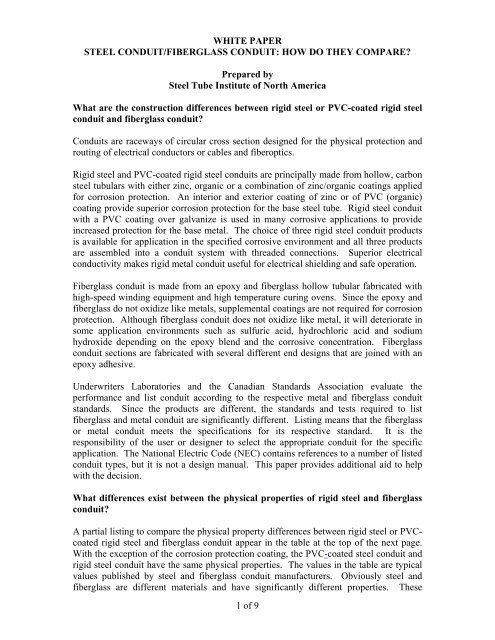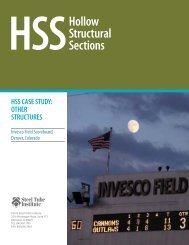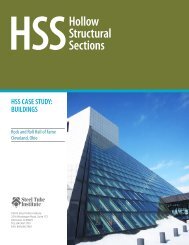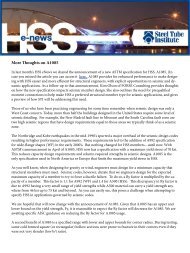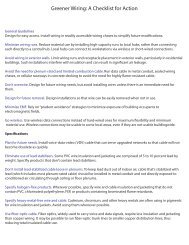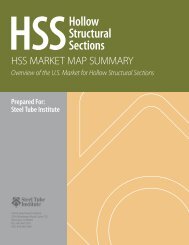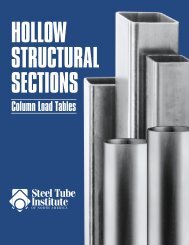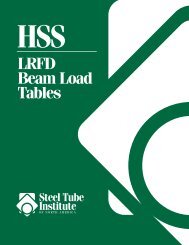HOW DO THEY COMPARE? - Steel Tube Institute
HOW DO THEY COMPARE? - Steel Tube Institute
HOW DO THEY COMPARE? - Steel Tube Institute
Create successful ePaper yourself
Turn your PDF publications into a flip-book with our unique Google optimized e-Paper software.
WHITE PAPER<br />
STEEL CONDUIT/FIBERGLASS CONDUIT: <strong>HOW</strong> <strong>DO</strong> <strong>THEY</strong> <strong>COMPARE</strong><br />
Prepared by<br />
<strong>Steel</strong> <strong>Tube</strong> <strong>Institute</strong> of North America<br />
What are the construction differences between rigid steel or PVC-coated rigid steel<br />
conduit and fiberglass conduit<br />
Conduits are raceways of circular cross section designed for the physical protection and<br />
routing of electrical conductors or cables and fiberoptics.<br />
Rigid steel and PVC-coated rigid steel conduits are principally made from hollow, carbon<br />
steel tubulars with either zinc, organic or a combination of zinc/organic coatings applied<br />
for corrosion protection. An interior and exterior coating of zinc or of PVC (organic)<br />
coating provide superior corrosion protection for the base steel tube. Rigid steel conduit<br />
with a PVC coating over galvanize is used in many corrosive applications to provide<br />
increased protection for the base metal. The choice of three rigid steel conduit products<br />
is available for application in the specified corrosive environment and all three products<br />
are assembled into a conduit system with threaded connections. Superior electrical<br />
conductivity makes rigid metal conduit useful for electrical shielding and safe operation.<br />
Fiberglass conduit is made from an epoxy and fiberglass hollow tubular fabricated with<br />
high-speed winding equipment and high temperature curing ovens. Since the epoxy and<br />
fiberglass do not oxidize like metals, supplemental coatings are not required for corrosion<br />
protection. Although fiberglass conduit does not oxidize like metal, it will deteriorate in<br />
some application environments such as sulfuric acid, hydrochloric acid and sodium<br />
hydroxide depending on the epoxy blend and the corrosive concentration. Fiberglass<br />
conduit sections are fabricated with several different end designs that are joined with an<br />
epoxy adhesive.<br />
Underwriters Laboratories and the Canadian Standards Association evaluate the<br />
performance and list conduit according to the respective metal and fiberglass conduit<br />
standards. Since the products are different, the standards and tests required to list<br />
fiberglass and metal conduit are significantly different. Listing means that the fiberglass<br />
or metal conduit meets the specifications for its respective standard. It is the<br />
responsibility of the user or designer to select the appropriate conduit for the specific<br />
application. The National Electric Code (NEC) contains references to a number of listed<br />
conduit types, but it is not a design manual. This paper provides additional aid to help<br />
with the decision.<br />
What differences exist between the physical properties of rigid steel and fiberglass<br />
conduit<br />
A partial listing to compare the physical property differences between rigid steel or PVCcoated<br />
rigid steel and fiberglass conduit appear in the table at the top of the next page.<br />
With the exception of the corrosion protection coating, the PVC-coated steel conduit and<br />
rigid steel conduit have the same physical properties. The values in the table are typical<br />
values published by steel and fiberglass conduit manufacturers. Obviously steel and<br />
fiberglass are different materials and have significantly different properties. These<br />
1 of 9
differences must be evaluated in light of the conduit system function. One must<br />
determine which conduit system provides the best protection for the enclosed wiring or<br />
cable system in the application environment and under the application conditions. The<br />
corrosives present in the environment; the physical properties required; and the economic<br />
factors should be carefully considered.<br />
PROPERTY PVC COATED or RIGID STEEL FIBERGLASS<br />
Tensile<br />
330 MPa (Min)<br />
47,863 psi<br />
76 MPa<br />
11,023 psi<br />
Elongation 29% 2%<br />
Hardness, HRB 65 Not Published<br />
Thermal Conductivity 320 BTU/ft 2 -hr- 0 F-in 2.0 BTU/ft 2 -hr- 0 F-in<br />
Electrical<br />
200 x 10 -6 ohms 1.1 x 10 14 ohms<br />
Conductivity<br />
Impact 350 ft-lbs. 30-140 ft-lbs.<br />
Joint Pull Out Force 18,000 lbs. (US Size 1; Metric 27) 1000 lbs. (Interference<br />
Joint)<br />
Corrosion Protection Excellent Excellent<br />
Weight (Specific 7.8 1.9<br />
Gravity)<br />
What other significant differences exist between steel and fiberglass conduit<br />
The material and property differences result in unique product performance differences.<br />
These technical performance differences must be considered and evaluated to make the<br />
best decision for the application. The following information documents some important<br />
parameters that should be carefully evaluated:<br />
1. Connection Differences<br />
Fiberglass conduit sections are bonded together with an epoxy resin<br />
adhesive system. The qualification tests in the fiberglass conduit<br />
standards require joint water tightness and/or joint separation tests<br />
depending on the design. The standards require that “Two joints in each<br />
trade size are to be assembled as intended.” or “according to the<br />
manufacturer’s installation instructions.” The joints are then tested<br />
according to the specification.<br />
Joints bonded for these tests are bonded under ideal conditions in a<br />
laboratory where the surfaces are clean, the conduit is new, the cleanliness<br />
is controlled, etc. On a job site the conduit may be stored in unclean<br />
environments for extended periods before installation commences.<br />
Surface cleanliness is extremely important to the formation of acceptable<br />
and durable adhesive fiberglass bonds. Experience confirms that joining<br />
the threaded ends of rigid steel and PVC-coated rigid steel conduit that<br />
have been stored under nearly every condition does not affect the physical<br />
integrity of the joint.<br />
2 of 9
The threaded steel conduit joint pullout values are nearly 20 times greater<br />
than fiberglass conduit. Not only are the initial pull out values with clean<br />
conditions much superior for steel conduit, the deleterious effects of field<br />
installation will have less relative effect with steel conduit. Confidence<br />
when an epoxy resin adhesive system is used to bond fiberglass conduit<br />
under adverse field conditions is an unknown entity.<br />
The adhesive system used to assemble fiberglass conduit is very sensitive<br />
to temperature as evidenced by the recommended use of several different<br />
adhesives depending on the ambient curing temperatures. Not only must<br />
construction personnel select and use the correct adhesive for the curing<br />
conditions, but they must also thoroughly clean and apply the adhesive to<br />
form a reliable joint. A significant concern exists because a joint failure<br />
can be catastrophic.<br />
2. Threaded Connection Interface<br />
The steel conduit threads provide a positive mechanical interface to<br />
maintain the connections between conduit sections. The mechanical<br />
interface also provides electrical continuity that enables the conductor to<br />
be used as a ground path. This electrical conductivity can also be used to<br />
confirm that the threads are appropriately engaged. If the connection is<br />
loose, the electrical resistance will be high and the loose joint can be<br />
detected and identified. Because fiberglass conduit is non-conductive, the<br />
integrity of a connection cannot be confirmed by a simple electrical<br />
continuity check.<br />
An electrical method to evaluate the integrity of a fiberglass conduit<br />
system installation is not possible. A mechanical method to evaluate the<br />
integrity of a fiberglass conduit system may be possible, but any<br />
recognized method would be time consuming, costly and of questionable<br />
reliability. For these reasons a method has not been proposed. If the<br />
integrity of a joint is not confirmed, the joint could fail during an<br />
unexpected impact or a seismic event regardless of how resistant the base<br />
material may be to the same loading.<br />
3. Electrical Shielding<br />
In addition to the physical protection provided by rigid conduit, the steel<br />
conduit acts as an electrical shield to prevent spurious signals from<br />
interfering with the wiring system protected by the conduit system. The<br />
fiberglass conduit system offers no EMI/RFI shielding because it is nonconductive.<br />
To provide the same degree of security as the steel conduit, it<br />
will be necessary to use more expensive shielded wire and cables. In<br />
today’s world of increasing security concern about terrorism threats, steel<br />
or PVC-coated conduit provides both the best electrical shielding and the<br />
best physical protection. Shielding data for metal conduit are available<br />
and documented in the GEMI program developed and available through<br />
3 of 9
the Georgia <strong>Institute</strong> of Technology and the <strong>Steel</strong> <strong>Tube</strong> <strong>Institute</strong> of North<br />
America.<br />
4. Conductivity<br />
The conductivity of the steel conduit system provides electrical protection<br />
that cannot be duplicated with a fiberglass system. The National Electric<br />
Code recognizes rigid steel conduit as an electrical conductor and ground<br />
return path; a separate ground wire is required for the fiberglass conduit<br />
system. Routinely monitoring the conductivity of the steel conduit system<br />
can provide a continuing check on system integrity; the non-conductive<br />
fiberglass conduit system affords no such opportunity. This could be very<br />
valuable to assess damage after an unexpected impact or a seismic event.<br />
5. Conduit System Aging<br />
Aging of fiberglass or metal conduit systems and the aging failure modes<br />
are a concern. It is very difficult to devise a single aging test that will<br />
characterize either the fiberglass or metal conduit system in an infinite<br />
number of existing applications. Increasing the temperature conditions<br />
will accelerate the aging process, but increasing the temperature too much<br />
will have unintended consequences and failure modes. Temperature is not<br />
the only parameter that can be used to artificially age a conduit system.<br />
Rigid steel and PVC-coated rigid steel conduit systems have a long history<br />
of successful performance for extended periods of time in nefarious<br />
environments; fiberglass conduit does not have similar historical operating<br />
data. With the absence of historical performance data, aging tests for<br />
fiberglass conduit systems should include long-term exposure data for the<br />
adhesive connections.<br />
6. Installation<br />
Commercial equipment and trained contractor personnel familiar with the<br />
bending procedures are readily available for steel conduit. <strong>Steel</strong> conduit<br />
offsets have been successfully implemented for years in an infinite number<br />
of installations in numerous applications. Special bending equipment is<br />
required to make offsets for fiberglass conduit. Training and special skills<br />
are required to make fiberglass conduit field offsets.<br />
7. Failure Modes<br />
The failure modes of fiberglass and steel conduit are significantly<br />
different. The primary function of the conduit system is to protect the<br />
wire or cable contained therein. A large impact load will dent the steel<br />
conduit; under a similar impact load fiberglass conduit will probably<br />
fracture. The fracture will expose the internal wiring to the environment.<br />
Water and other corrosive elements now have direct access to the<br />
fiberglass filaments and water will wick along the individual filaments<br />
causing additional damage. If the dented area on coated steel conduit has<br />
4 of 9
penetrated the PVC coating, the galvanize coating on the conduit will<br />
continue to offer protection. Touch-up compound can be painted over the<br />
damaged area to provide additional protection.<br />
It is much more difficult and risky to attempt to touch-up the fractured<br />
area on fiberglass conduit because of the jagged failure. As the touch-up<br />
area is exposed to additional weathering and humidity, moisture will<br />
penetrate the patch area and wick along the glass fibers leading to a<br />
subsequent failure as the epoxy separates from the glass fibers.<br />
8. Re-Making Connections<br />
Re-make capability with an adhesive fiberglass conduit joint is more<br />
cumbersome than re-make with a rigid steel or PVC-coated rigid steel<br />
conduit threaded coupling. If a section of fiberglass conduit is damaged in<br />
service or must be replaced because of changes to the wiring scheme, the<br />
fiberglass system must be replaced or sections shortened to make new<br />
joints. A damaged steel conduit section with threads can be reused several<br />
times without making new joints.<br />
9. Thermal Conductivity<br />
The higher thermal conductivity of steel removes heat more quickly from<br />
the enclosed wiring and cable systems. The respective thermal<br />
conductivities are shown in the physical properties table appearing on<br />
page 2. The lower operating temperature of the wire and cable system will<br />
increase the operating life of the wire and cable system.<br />
10. Electrical Fault Conditions<br />
Fiberglass conduit will not melt or weld the wire to the inside of the<br />
conduit under fault conditions as can happen with rigid steel or PVCcoated<br />
rigid steel conduit. If a fault condition is severe enough to melt or<br />
weld wire to the inside of the steel conduit, it must be severe enough to<br />
melt or puncture the insulation on the enclosed wire or cable. During such<br />
a fault the grounding wire will be compromised and the ground system<br />
will require replacement in a fiberglass conduit system.<br />
Fault conditions are equally bad in either conduit system and wire<br />
replacement will usually be necessary. Among other considerations it<br />
depends on the magnitude of fault current, the duration of the fault and the<br />
associated arc damage whether the steel conduit must be replaced when<br />
wire welds to the inside of the steel conduit. The same considerations and<br />
arc burn will damage and carbonize the surface of fiberglass conduit. In<br />
some instances it may be possible to remove the conductors and clean the<br />
interior of rigid steel conduit.<br />
5 of 9
11. Weight<br />
Fiberglass conduit is lighter weight than rigid steel or PVC-coated rigid<br />
steel conduit. This property offers an advantage when designing the<br />
support system; however, the added weight of steel conduit provides<br />
significant application benefits including better fulfillment of the primary<br />
goal, i.e., protection of wiring from physical damage. As outlined above<br />
the steel conduit and the coupling method will protect better against<br />
unexpected impact loads. It also provides security benefits that fiberglass<br />
conduit cannot provide without additional measures.<br />
12. Corrosion Protection<br />
Corrosion protection is unique to the environment, but a comparison of the<br />
published corrosion resistance tables for fiberglass conduit and PVC<br />
coated steel conduit show that PVC coated steel conduit has application in<br />
several environments not recommended for fiberglass conduit. An<br />
example where PVC coated conduit is better than epoxy fiberglass is<br />
sulfuric acid dependent on the temperature and concentration. This is a<br />
function of the corrosives that appear in the application environment and<br />
is unique to the application. Corrosion protection must be evaluated for<br />
the specific application.<br />
13. Vibration<br />
Another concern is vibration in the application. Rigid steel conduit joints<br />
have been applied for many years under the vibration conditions that could<br />
be expected in a specific application such as a bridge. No requirements<br />
are specified for vibration testing of fiberglass conduit joining methods.<br />
14. Connection Pullout Strength<br />
As reported in a Fiberglass Conduit catalog, the average pullout strength<br />
of a trade size 4 fiberglass conduit joint is 11,270 psi. This is an unusual<br />
method to report a pullout value. Tensile test machines measure pullout<br />
force in lbs, not psi. In the Fiberglass Conduit catalog the pullout strength<br />
is calculated as the average ultimate value times the cross sectional area of<br />
the conduit. The calculated cross sectional area of the conduit is 3.34 sq<br />
in, i.e. the pullout strength is 3.34 sq. in. x 11, 270 psi = 37,642 pounds.<br />
The anticipated failure mode during the pullout test of either fiberglass or<br />
coated/rigid steel conduit will be for the conduit to pull out of the fitting,<br />
whatever fitting may be used in the test. For fiberglass conduit the pullout<br />
strength will depend on the integrity of the adhesive bond between the<br />
conduit section and the fitting (coupling, elbow, tee, whatever). The<br />
pullout strength is completely independent of the cross section of the<br />
conduit unless the fiberglass conduit fails; the pullout strength is<br />
dependent on the adhesive contact surface area. The coated metal conduit<br />
6 of 9
pullout strength will depend on the mechanical interface of the metal<br />
threads and the tensile strength of the steel.<br />
The pullout strength of the fiberglass, galvanized rigid steel, PVC-coated<br />
rigid steel and PVC-coated rigid steel galvanized conduit is dependent on<br />
proper assembly procedures. Joints made by turning threaded conduit into<br />
couplings is obviously less complicated than cleaning ends, choosing the<br />
correct adhesive and assuring the use of proper application procedures.<br />
Delays while waiting for adhesive cure are also a consideration. The<br />
threaded steel conduit is much less susceptible to assembly problems as<br />
compared to fiberglass adhesive.<br />
Since the fiberglass conduit test unit was probably assembled in a<br />
laboratory under pristine conditions, the published test value will be<br />
difficult to match during field installation. Using data presented in the<br />
Fiberglass Conduit vendor catalog, the measured pullout values for the<br />
trade size 4 fiberglass conduit was 37,642 lbs. This is an average value<br />
based on three test results. The condition of the fiberglass conduit after<br />
the tests is not described. Based on data from a UL Fact-Finding Report,<br />
the minimum average pullout strength for trade size 4 rigid steel conduit is<br />
93,250 lbs.<br />
15. Thermal Expansion<br />
The coefficient of thermal expansion (CTE) for fiberglass conduit is 1.5 x<br />
10 -5 in/in/ 0 F. The CTE for steel conduit is 0.65 x 10 -5 in/in/ 0 F. The PVC<br />
coating has absolutely no impact on the CTE for coated steel conduit; the<br />
CTE for PVC-Coated and Rigid <strong>Steel</strong> Conduit are the same. The thermal<br />
expansion of rigid steel and PVC-coated rigid steel conduit is less than<br />
half the thermal expansion of fiberglass conduit. The difference in CTE<br />
means that the distance between expansion joints can be increased<br />
significantly with steel conduit. The thermal expansion is independent of<br />
the conduit size.<br />
16. Impact Strength<br />
Impact test loads are normally expressed in ft-lbs or in-lbs; the published<br />
impact value for trade size 4 fiberglass conduit is 180 lbs. at -40 0 F (-40 0<br />
C). It is unclear from the published data exactly how the impact resistance<br />
of fiberglass conduit was determined or the reason it is not expressed in ftlbs<br />
or in-lbs. Trade size 4 rigid steel conduit has a confirmed test impact<br />
resistance of 375 ft-lbs. If the published fiberglass value of 180 lbs is<br />
actually 180 ft-lbs, then the rigid steel conduit has twice the impact<br />
strength of similar size fiberglass conduit.<br />
Another very important question is the condition of the conduit after the<br />
impact test. The impact resistance of the trade size 4 coated steel conduit<br />
is 375 ft-lbs. A 25 lb. weight was dropped from a height of 15 ft on the<br />
metal conduit. The dent on the steel conduit made by the falling weight<br />
7 of 9
educed the cross sectional area of the steel conduit by 10%, but the<br />
conduit was functional and did not fracture. The internal conductors<br />
were not damaged from the impact. The failure mode with fiberglass<br />
conduit will be much different. The fiberglass will fracture and expose the<br />
internal wiring to sharp fragments of fiberglass or epoxy. Under these<br />
conditions the internal wiring may be damaged and could be exposed to<br />
the existing environmental conditions.<br />
The fact that the impact test was made at -40 0 F (-40 0 C) is not significant.<br />
<strong>Steel</strong> or coated steel conduit will maintain its impact strength at this<br />
temperature. At much colder temperatures such as -75 0 F or more, the<br />
steel may become brittle. This is not an issue unless the conduit<br />
installation is in Antarctica or Arctic regions.<br />
Conclusion<br />
This is not a complete listing of technical points that should be considered when selecting<br />
a conduit system. It does present several important differences that should be evaluated in<br />
addition to the economics when determining the most appropriate system for the<br />
application. Data presented in this white paper were provided from testing performed by<br />
a group of producers under the auspices of industry associations and the published<br />
literature from fiberglass manufacturers. If you have any additional questions about the<br />
information in this document, you may contact a producer of either steel or PVC-coated<br />
rigid steel conduit.<br />
8 of 9
Bibliography<br />
References used to prepare the information in this paper include:<br />
1. CHAMPION DUCT Fiberglass Conduit; 2003 by Champion Fiberglass, Inc.,<br />
6400 Spring Stuebner Road, Spring, Texas 77389. Catalog available at<br />
www.championfiberglass.com.<br />
2. Allied IMC Specification Guide ATC-L-1526; Allied <strong>Tube</strong> & Conduit available<br />
at www.atcelectrical.com.<br />
3. ROBROY Industries Product Bulletins & Catalogs for PLASTI-BOND<br />
REDH2OT, PERMA-COTE and KORKAP Coated Conduit; information<br />
available at www.robroy.com.<br />
4. EPON ® Resin Structural Reference Manual; 2001 Resolution Performance<br />
Products.<br />
9 of 9


